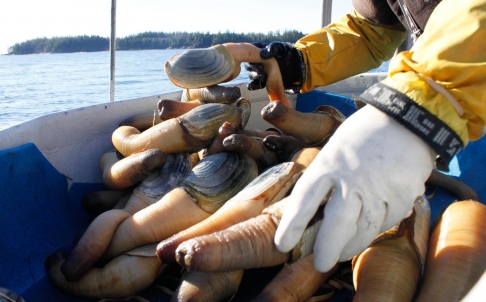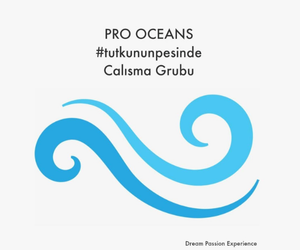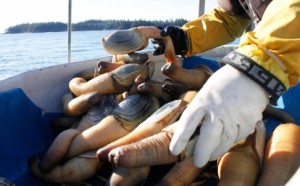From a basket hoisted on the back of his trawler, fisherman Freddy Gutmann proudly picks up a giant geoduck clam fresh from the frigid waters off the northwestern Canadian coast.
“This one is a great specimen,” Gutmann says as sea water gushes from the massive fleshy mollusc that measures an impressive 20cm.
Gutmann has good reason to be in high spirits, since within 24 hours, the super-sized shellfish – shunned by Western chefs – will be served at top restaurants in Hong Kong, Beijing or Tokyo for a steep price.
Without missing a beat, the 35-year veteran of the Pacific waters swiftly fills three orange cases with his sorted and cleaned catch so they can be rushed to the airport in Vancouver – and on to Asia.
A kilogram of geoduck fetches C$30 (HK$210) for the fishermen and six times that for a fine restaurant. But that was not always the case, recalled Gutmann.
“Fifteen years ago, its price was around 30 cents per pound, maximum,” he said.
What is more, licences to harvest such clams were once available for a pittance.
“Licence owners got them for a couple bucks. Sometimes they were given [away] by the government,” said the native of Tofino, a small seaside town in the province of British Columbia. Today, however, “they’re worth C$4 to C$5 million”, he added.
In the port of Tofino, mariners talk of astronomically high fees of C$50 million per permit and annual salaries of C$200,000 – all difficult to believe and verify.
But just 55 fishing permits have been issued by Canadian authorities, who are not planning to increase that quota – even though environmentalists say the geoduck population is overabundant.
The distinctive clams – sometimes evocatively referred to as “horse penis clams” – can be found all the way from Mexico’s Baja California Peninsula to Alaska. But they are particularly prevalent off the shores of the US state of Washington and in neighbouring British Columbia.
Harvesting the shellfish is no easy task. It takes two divers, weighed down by 30kg belts and taking turns, over 12 hours to plunge 15 to 20 metres into the dark waters to wrest the geoducks from the sandy Pacific floor.
Dressed in thick wetsuits and attached to a boat by a 300 metre air hose, the divers scour the sea floor for tiny holes that suggest the presence of a clam, often buried under a metre of sand. They plunge their arms in and try to wrestle the muscular shellfish out.
“You’ve got your ears against the sand – you hold it, but it’s fighting to leave,” said David Thomas, who has spent 27 of his 48 years searching for geoducks.
Thomas – who works with Gutmann – swears this season will be his last. Sometimes, the underwater current was so strong that it plastered you to the sea floor, he said.
Perhaps surprisingly, Thomas, Gutmann and the boat’s third crew member haven’t become culinary fans of the clams.








